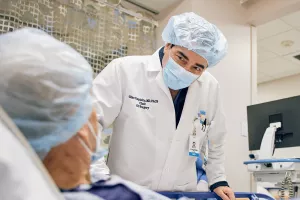Prostate cancer is a very common genitourinary cancer that develops in the gland cells of the prostate, a male organ located between the bladder and the base of the penis.
Are you proactive with your prostate health?
Prostate cancer is one of the most curable forms of cancer with early detection. Because prostate cancer doesn't often show symptoms in its earlier stages, it's important to talk with your doctor about how you can stay one step ahead of your prostate health.
We encourage people with an average risk of developing prostate cancer to take their health into their own hands and receive routine cancer screenings starting at age 50 (or earlier, depending on your personal health history). You owe it to yourself and your loved ones to take your prostate health seriously. And we owe it to you to make that process as convenient as possible.

Conditions
Prostate cancer takes several different forms like:
- Adenocarcinoma: This is the most common type of prostate cancer. It starts in the gland cells that line the prostate and tends to grow slowly.
- Sarcoma: This rare type of prostate cancer starts in the connective tissue of the prostate. It tends to be more aggressive and spreads quickly.
- Small cell carcinoma: This is a rare and aggressive form of prostate cancer. Less than 2% of people living with prostate cancer have small cell carcinoma.
Prostate cancer symptoms
Prostate cancer may not produce any symptoms in its early stages. However, more advanced cases may show signs such as:
- Urinary frequency or urgency
- Decreased urinary stream
- Pain or discomfort with urination
- Weaker urination
- Blood in the urine or semen
- Discomfort in the pelvic area
- Swelling in the legs
- Bone pain
- Difficulty with erections
If you notice any of these symptoms, talk to your doctor to determine if the symptoms are from prostate cancer, or else from conditions like an infection or benign prostatic hypertrophy, a non-cancerous condition where the prostate gland gets bigger as you age, or from other causes.
Testing
Prostate cancer screening
If found early, prostate cancer is very treatable with a high chance of cure. Screening for prostate cancer takes place in two ways:
- A blood test that measures for a prostate-specific antigen (PSA)
- A digital rectum exam that feels for irregularities in the prostate
PSAs are present in all people with a prostate, both men and those assigned male at birth (AMAB). High PSA levels may indicate prostate cancer but may simply be elevated from an enlarged prostate gland or a prostate infection.
Talk with your doctor about your health and family history to learn how often and at what age your prostate cancer screenings should take place. If there is a concern for prostate cancer, a biopsy is necessary to confirm the diagnosis.
Diagnosis and staging
Diagnosing prostate cancer starts with a biopsy where we take a tiny piece of tissue from your body to examine it more closely. We then test the tissue to determine if the prostate cancer is aggressive or slow-growing and whether it has spread outside of the prostate. This testing process is called "staging" and may include:
- A digital rectal exam
- Ultrasound
- MRI or CT scan of the pelvis
- Nuclear medicine testing (bone scan or PET scan)
Treatments
Your prostate cancer treatment path depends on several factors:
- The stage of your prostate cancer
- Other health conditions that may influence treatment options
- Your preference for the side effects that come with treatment
Our goal is to make sure you get the information you need to make a treatment choice that fits you best.
Treatment paths
If your prostate cancer is considered low risk, we’ll keep a close eye on your progress. This method is called active surveillance, and it usually includes:
- Monitoring your PSA levels
- Periodic digital rectal examinations
- Periodic prostate biopsies or imaging
Active surveillance may allow some people with prostate cancer to avoid unnecessary treatment, or else to only pursue treatment if there are signs of growth. Your doctors will discuss the risks and benefits of this option based on your disease and preferences.
In most cases of localized prostate cancer, surgery can completely remove the tumor. Your surgeon can tailor the surgery to remove the prostate and sometimes the nearby lymph nodes to best improve your chance of cure. We also use nerve-sparing techniques that may help preserve erections and sexual function.
Your surgery may be laparoscopic (minimally invasive robotic surgery with a small incision) or open (invasive surgery with a large incision). Your surgeon will discuss the risks and benefits of both approaches with you.
Radiation therapy is also an effective way to treat prostate cancer. There are 2 types of radiation therapy for prostate cancer: External beam radiotherapy and brachytherapy.
External beam radiotherapy
High-energy X-rays are given in 5-15 minute outpatient treatments. Treatments are customized to your disease and given in multiple sessions usually over 2-6 weeks. For more advanced prostate cancer, we may add hormonal treatment which can improve the success of radiation.
Should prostate cancer recur after surgery, radiation may sometimes also help as a second chance for a cure. Whether used instead of surgery or after surgery, your radiation oncologist can discuss the risks and benefits of with treatment with you.
The technical terms for this type of radiation include imaged guided radiation therapy (IGRT), intensity modulated radiation therapy (IMRT), and stereotactic body radiation therapy (SBRT). Ask your doctor which of these techniques are most appropriate for you.
Brachytherapy
Another strategy is to place radioactivity into the prostate, which lessens the amount of radiation to other normal tissues. It is used less frequently than external beam radiation but can be an effective option for the right people. Ask your doctor whether this approach is reasonable for you.
Chemotherapy is commonly used for metastatic prostate cancer when hormone therapy is no longer working well. Instead of blocking testosterone, chemotherapy targets fast-growing cells. People usually receive treatment intravenously (directly within a vein), which gives the body time to recover in between sessions.
Some drugs can find and mark your prostate cancer so that your immune system can treat it in a different way than it would with hormone therapy or chemotherapy. This newer treatment is usually used when the prostate cancer has spread and isn't responding well to other medications. Talk to your doctor about how these drugs are being used today and about clinical trials you might join.
This new treatment helps deliver radiation directly to prostate cancer that has spread and no longer responds to hormone therapy. A radioactive element, lutetium-177 (Lu-177) is linked to an antibody attracted to the outside surface of the prostate cancer cells — the prostate-specific membrane antigen (PSMA). Injected intravenously (directly within a vein), it travels to target prostate cancer anywhere in the body.
When prostate cancer has spread only to the bone, another option is radium-226 (Ra-226). This travels mainly to the bone and doesn’t need to be attached to an antibody to be effective.
Both of these treatments require some radiation precautions but usually aren’t a concern after 2-3 days. Ask your oncologist whether these treatments may be a good option for you.
FAQs
The prostate is responsible for producing seminal fluid that nourishes sperm.
In the United States, prostate cancer is the most common cancer that affects only men and people assigned male at birth (AMAB). More than 230,000 new cases of prostate cancer are diagnosed each year.
Certain factors can make people more likely to develop prostate cancer. Some of these factors include:
- Race and ethnicity: African American men are more likely to develop prostate cancer than other ethnicities.
- Family history: People with one immediate family member with prostate cancer have twice the increased lifetime risk.
- Obesity: People with prostate cancer who are clinically obese are more likely to have an advanced condition that’s more difficult to treat.
- Age: The incidence of prostate cancer increases with age. Most cancers are diagnosed between the age of 60 and 75.

From regular office visits to inpatient stays, find the healthcare you need and deserve close to home.

Meet the doctors and care team devoted to supporting you every step of the way along your path to better health.